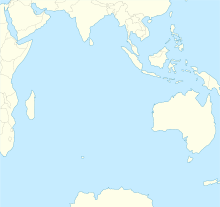Cocos (Keeling) Islands Airport Lapangan Terbang Pulu Koko | |||||||||||
|---|---|---|---|---|---|---|---|---|---|---|---|
 Aerial view in the direction of Runway 33 | |||||||||||
| Summary | |||||||||||
| Airport type | Public | ||||||||||
| Operator | Toll Remote Logistics | ||||||||||
| Location | West Island, Cocos (Keeling) Islands | ||||||||||
| Elevation AMSL | 10 ft / 3 m | ||||||||||
| Coordinates | 12°11′19″S 096°49′50″E / 12.18861°S 96.83056°E | ||||||||||
| Website | cocosislandairport | ||||||||||
| Map | |||||||||||
Location on a map of the Indian Ocean | |||||||||||
| Runways | |||||||||||
| |||||||||||
| Statistics (2010/11[a 1]) | |||||||||||
| |||||||||||

Cocos (Keeling) Islands Airport (Cocos Islands Malay: Lapangan Terbang Pulu Koko (Keeling)) (IATA: CCK, ICAO: YPCC) is an airport serving the Cocos (Keeling) Islands, a territory of Australia located in the Indian Ocean. The airport is on West Island, one of the South Keeling Islands and capital of the territory.
YouTube Encyclopedic
-
1/5Views:1 6885 306123 9482 71917 195
-
Cocos Island Visual approach & landing runway 15
-
Approach and landing at Cocos (Keeling) Islands
-
Cocos Keeling Islands - Fresh Escapes - Home Island
-
Take off from Cocos (Keeling) Islands
-
Travel To Cocos island | Full History And Documentary |Cocos island In Urdu & Hindi | کوکوس کی سیر
Transcription
History

The airfield was built during World War II to support Allied aircraft in the war against Japan. Two airstrips were built, and three bomber squadrons were moved to the islands to conduct raids against Japanese targets in Southeast Asia and to provide support during the planned re-invasion of Malaya and reconquest of Singapore. The first aircraft to arrive were Supermarine Spitfire Mk VIIIs of No. 136 Squadron RAF.[3] They included some B-24 Liberator bombers from No. 321 (Netherlands) Squadron RAF (members of exiled Dutch forces serving with the Royal Air Force), which were also stationed on the islands.
The 2016 Australian Defence White Paper stated that the airfield would be upgraded to support the RAAF's P-8 Poseidon maritime patrol aircraft.[4] Work was scheduled to begin in early 2023 and completed by 2026, though the costs of the upgrade had increased significantly. It is planned that the airfield will act as a forward operating base for Australian surveillance and electronic warfare aircraft in the region.[5][6]
Facilities
The airport has one runway, designated 15/33, with an asphalt surface measuring 2,441 m × 45 m (8,009 ft × 148 ft) and an elevation of 10 ft (3 m) above sea level.[1]
Airlines and destinations
| Airlines | Destinations |
|---|---|
| Toll Global Express | Christmas Island, Perth |
| Virgin Australia Regional Airlines | Christmas Island, Perth |
Statistics
Cocos Island Airport served 14,896 revenue passengers during financial year 2017–2018.[a 1][2]
| Year[a 1] | Revenue passengers | Aircraft movements |
|---|---|---|
| 2001–02 | 4,740 |
218
|
| 2002–03 | 4,328 |
212
|
| 2003–04 | 4,976 |
218
|
| 2004–05 | 5,631 |
226
|
| 2005–06 | 5,632 |
224
|
| 2006–07 | 6,501 |
232
|
| 2007–08 | 6,510 |
320
|
| 2008–09 | 5,611 |
238
|
| 2009–10 | 9,129 |
302
|
| 2010–11 | 15,712 |
303
|
| 2011–12 | 7,957 |
277
|
| 2012–13 | 14,478 |
454
|
| 2013–14 | 8,664 |
398
|
| 2014–15 | 11,323 |
360
|
| 2015–16 | 17,659 |
308
|
| 2016–17 | 16,387 |
345
|
| 2017–18 | 14,896 |
260
|
See also
References
Footnotes
Notes
- ^ a b YPCC – Cocos (Keeling) Island (PDF). AIP En Route Supplement from Airservices Australia, effective 21 March 2024, Aeronautical Chart Archived 10 April 2012 at the Wayback Machine
- ^ a b c "Airport Traffic Data 1985–86 to 2010–11". Bureau of Infrastructure, Transport and Regional Economics (BITRE). May 2012. Archived from the original on 24 March 2012. Retrieved 27 June 2012. Refers to "Regular Public Transport (RPT) operations only"
- ^ Fail, J.E.H. "FORWARD STRATEGIC AIR BASE COCOS ISLAND". rquirk.com. Archived from the original on 7 February 2013. Retrieved 13 February 2013.
- ^ "2016 Defence White Paper (para. 4.66)" (PDF). defence.gov.au. Archived (PDF) from the original on 1 March 2016. Retrieved 26 February 2016.
- ^ "$384m cost blowout on ADF plan to upgrade airstrip, boost military presence on Cocos (Keeling) Islands". ABC. 15 January 2023. Retrieved 19 August 2023.
- ^ Layton, Peter (29 June 2023). "Australian Defence's Forgotten Indian Ocean Territories". Griffith Asia Insights. Retrieved 19 August 2023.
Further reading
- McGrath, Tony (2019). In Tropical Skies: A History of Aviation to Christmas Island and Cocos (Keeling) Islands. Carlisle, WA: Hesperian Press. ISBN 9780859057561.
External links
- Cocos Islands Airport: a pictorial history archived version – compiled by Geoff Goodall
- Photos of the Cocos (Keeling) Islands Airport

